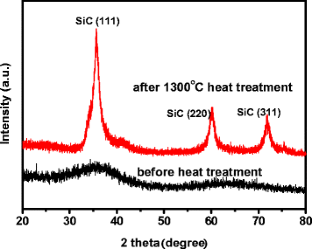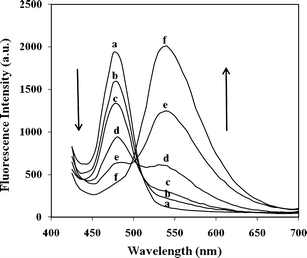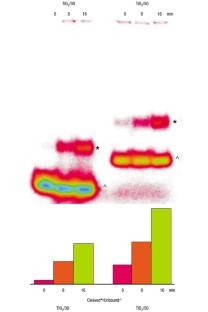41 semiconductor nanocrystals as fluorescent biological labels
Nanomaterials | Special Issue : Nanomaterials for Applied ... - MDPI The engineering of delivery systems for drugs and contrasting labels ensuring the simultaneous imaging and treatment of malignant tumors is an important hurdle in developing new tools for cancer therapy and diagnosis. ... (DOX) as a model anticancer drug, and fluorescent semiconductor nanocrystals (quantum dots, QDs) as fluorescent nanolabels ... A Critical Scrutiny on Liposomal Nanoparticles Drug Carriers as ... Owing to these properties, QDs have been studied for biochemical applications as fluorescent probes. It is reported that QDs are particularly useful for in vivo cell labeling and imaging [ 35 - 38 ]. Table 2 shows some of the applications of nanoparticles (NPs) in the medical field. Table 2
Advances and Challenges of Fluorescent Nanomaterials for ... - SpringerOpen Nanocrystals and microcrystals of semiconductors were grown in glass matrices. With the development of fluorescent materials, QDs have been prepared by different methods, such as direct adsorption method, linker-assisted adsorption method, situ methods and the combination of previous preparation methods.

Semiconductor nanocrystals as fluorescent biological labels
Cd+2-sensing property of highly luminescent CdTe nanocrystals in the ... In semiconductor NC-based sensors, the fluorescence signals of NCs undergo three changes in the presence of ions, including a shift at the fluorescence peak position, fluorescence enhancement (turn-on mode), and fluorescence quenching (turn-off mode). Synthesis and Characterization of Carbon Nanofibres from Luffa Fibres ... Coe s, et al. Electroluminescence from single monolayer of nanocrystals in molecular organic devices. Nature. 2002;420:800-803. [Google Scholar] Brunchez M, et al. Semiconductor nanocrystals as fluorescent biological labels. Science. 1998;281:2013-2016. [Google Scholar] Yu DG. Quantum dot - Wikipedia Quantum dots ( QDs) are semiconductor particles a few nanometres in size, having optical and electronic properties that differ from larger particles due to quantum mechanics. They are a central topic in nanotechnology. When the quantum dots are illuminated by UV light, an electron in the quantum dot can be excited to a state of higher energy.
Semiconductor nanocrystals as fluorescent biological labels. How do you prepare quantum dots? - Peculiarities Bite Colloidal fluorescent semiconductor nanocrystals known as quantum dots are roughly spherical, have distinctive optical, electronic, and photophysical properties, and have exciting potential uses in biological labeling, imaging, and detection as well as as effective fluorescence resonance energy transfer donors. What are quantum dots used for? Nanomaterials | Free Full-Text | Fluorescent Biosensors Based on ... In fluorescent sensors, Si NWs are employed as substrate and coupled with several fluorophores, NWs can be used as quenchers in stem-loop configuration, and have recently been used for direct fluorescent sensing. A dual-colored bio-marker made of doped ZnO nanocrystals bio-images labeled by one semiconductor nanocrystal colloidal solution. Bright green emission was detected on mung bean seedlings labeled by all the synthesized ZnO nanocrystals. Cytotoxicity tests showed that the aminosilanes capped nanoparticles are non-toxic. Quantum yields of the nanocrystals varied from 79% to 95%. Jadhav, S. V., Nikam, D. S., Khot, V. M., Thorat, N. D., Phadatare, M ... References Listed. These are the references the publisher has listed as being connected to the article. Please check the article itself for the full list of references which may differ.
Multichannel Fluorescence Microscopy: Advantages of Going beyond a ... There is a large variety of luminescent particles that are used in microscopy studies, such as semiconductor nanocrystals ... cellular organelle: B.1) nucleus in green channel, and C.1) acting filaments in red channel making use of distinct fluorescent labels. ... multilabeling can facilitate the full understanding of biological processes that ... Multifaceted Approaches to Engineer Fluorescence in Nanomaterials via a ... In this paper, we summarize the assortment of laser operations for the fabrication, modification, and spatial positioning of various fluorescent nanomaterials, ranging from metallic nanoparticles, carbon dots, 2D ultrathin films to wide-bandgap nanomaterials, and upconversion nanocrystals. Competitive Performance of Carbon "Quantum" Dots in Optical Bioimaging Small carbon nanoparticles have been shown as versatile precursors for brightly fluorescent nano-dots 1-15, with the observed optical properties in solution phenomenologically similar to and performance-wise comparable with those of the well-established semiconductor quantum dots (QDs) 9, 16-19. Nanotechnology and nanomaterial Semiconductor nanocrystals are being used as fluorescent biological labels. sensors based on nanotechnology will revolutionize health care, climate control and detection of toxic substances. nanochips to carry out complete chemical analysis. Such nano-total analysis systems will have to employ new approaches to valves, pipes, pumps, separations ...
Structural Design of Multidentate Copolymers as Compact Quantum Dot ... Quantum dots (QDs) are a class of semiconductor nanocrystal used broadly as fluorescent emitters for analytical studies in the life sciences. These nanomaterials are particularly valuable for single-particle imaging and tracking applications in cells and tissues. An ongoing technological goal is to reduce the hydrodynamic size of QDs to enhance access to sterically hindered biological targets ... Employing Synergistic Strategies to Advance Nanomedicine researchers believe that overcoming existing challenges will require two synergistic strategies: (1) thorough in vitro screens to help understand key cellular qualities resulting in nanocarrier therapeutic success, and (2) the advancement and use of adequate, relevant models to relate cellular and tissue-specific nanocarrier selectivity with … High-quantum yield alloy-typed core/shell CdSeZnS/ZnS quantum dots for ... Quantum dots (QDs) have been used as fluorophores in various imaging fields owing to their strong fluorescent intensity, high quantum yield (QY), and narrow emission bandwidth. However, the application of QDs to bio-imaging is limited because the QY of QDs decreases substantially during the surface modification step for bio-application. Results Quantum dots and photodynamic therapy in COVID‐19 treatment When UV light hits these crystals they can emit light of various colors, and this property has found many applications such as solar cells, fluorescent biological labels, and composite materials. 13, 14 Quantum dots are typically made up of an insulating or semiconductor element, such as carbon (almost always bonded to hydrogen), 15, 16 silicon ...
Universal precursors dispersed in Vaseline-octadecene gel for ... A great variety of high-quality inorganic nanocrystals are synthesized solely in hydrocarbon solvents in both academic and industrial settings on a daily basis, which is largely complicated by lack of simple precursors containing inorganic element (s) yet soluble in the reaction solvents at ambient temperatures.
Effects of Carboxyl or Amino Group Modified InP/ZnS Nanoparticles ... Semiconductor Nanocrystals as Fluorescent Biological Labels. Science 281, ... Quantum dots (QDs), also known as nanoscale semiconductor crystals, are nanoparticles with unique optical and ...

Quantum dot–NBD–liposome luminescent probes for monitoring phospholipase A 2 activity | SpringerLink
Interface polarization in heterovalent core-shell nanocrystals The potential profile and the energy level offset of core-shell heterostructured nanocrystals ( h -NCs) determine the photophysical properties and the charge transport characteristics of h -NC...
Impact of Silver Nanoparticles on Neurodevelopment and Neurodegeneration Silver nanoparticles (AgNPs) are one of the most highly commercialized nanoparticles, having been used extensively as an antimicrobial agent in cosmetics, textiles, foods, and the treatment of diseases. However, the impact of AgNPs on human mental health has not yet been well characterized.
Histology, Staining Article - StatPearls Recently, there has been the use of fluorolabeling, where a fluorogenic semiconductor releases small 6nm nanoparticles at the silver depositions and produces colors. The diameter range of the silver particles that form correlates to different colors.
SpectraDot™ Fluorescent Nanocrystals - Spectra Genetics - GPCR Internalization and Trafficking ...
Analysis of Protease Activity Using Quantum Dots and Resonance Energy ... However, compared to two fluorescent proteins, some advantages of QD-fluorescent protein encompass 5-10 times less substrate and ~3 orders of magnitude less enzyme in terms of quantity to be used. As a result, they were able to detect enzymatic activity for caspase 3 concentrations as low as 20 pM.
Size focusing of colloidal quantum dots under high monomer concentration The photoluminescence (PL) full width at half maximum (FWHM) of CdS CQDs can be narrowed down to below 80 meV for PL peaks from 430 to 500 nm. Given the inevitable usage of the ligands in the solution synthesis of colloidal nanocrystals, the influence of morphology difference on growth rate should be common.
Time for NanoNeuro | Nature Methods Upconverting nanoparticles (UCNP) are nanoscale NPs, with a diameter of 1-100 nm, that exhibit photon upconversion, whereby multiple low-energy photons are absorbed and converted into a high-energy...




Post a Comment for "41 semiconductor nanocrystals as fluorescent biological labels"